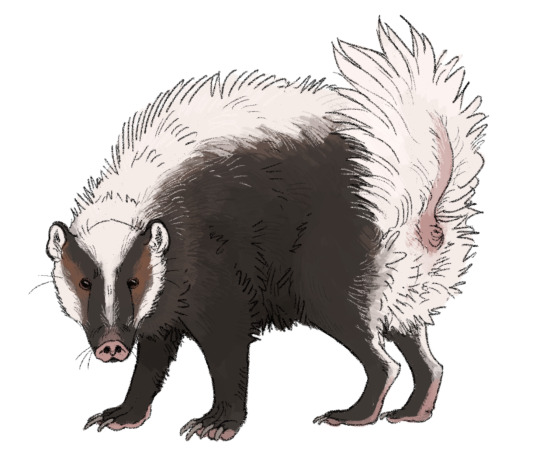#are covered in fur. But I suppose one Could in theory have aposematic coloring on a large area of bare skin that's like.
Explore tagged Tumblr posts
Text

The wassibi, threatening you with a very bad time.
Wassibi are mid-sized (11-16 lb) solitary mustelids. This species is native throughout the lands south of the Viper seaway, thriving as generalists in a great diversity of habitats (though rarely occur in very arid environments or at high elevations). They are omnivores, using their broad noses and strong claws to dig out earthworms, beetle larvae, roots and tubers, foraging along the ground for insects, scorpions, bird eggs, fallen fruit, and small lizards and snakes, and occasionally scavenging carcasses and trash. They are particularly noted for their ability to find honey- splitting open bees nests with their claws and leisurely consuming larvae and honeycomb, seemingly untroubled by bee stings.
Wassibi are known above all else for their devastatingly noxious defensive anal gland spray. When threatened, they hiss, arch their backs and tails, raise their fur, and point their anus menacingly in the direction of danger. Should posturing fail, they will unleash their spray at the threat's face. Their anal glands have powerful muscular control and the attack is devastatingly accurate at up to 10 ft. In addition to having an atrocious stench, the liquid is mildly irritating to the skin, painful and temporarily blinding to the eyes, and can induce intense nausea and vomiting. The smell is resistant to washing, and can take weeks to fade. Most predators who experience a hit will learn to recognize the wassibi's stark aposematic coloring and avoid anything resembling it.
In addition to this potent defensive weaponry, they have dense fur and thick, loose skin, which renders them difficult for most predators to effectively grasp or pierce without risk of being bitten themselves. As such, wassibi have few consistent natural predators and are given a wide birth by most other animals. Their tendency to walk boldly in the open and sometimes even scavenge at carcasses alongside much larger predators commonly lends them cultural reputations of fearlessness. Wassibi are known for attacking large venomous snakes that potentially threaten their young, which (along with their frequent consumption of scorpions and bees) leads to common misconceptions that they are entirely immune to venom. They have no such resistance, rather their thick fur and loose skin cause bites and stings to land less effectively- most stings fail to penetrate their fur altogether, and bites often deal glancing blows that inject little to no venom.
Their biggest predatory threats come from humans. Wassibi meat is fairly rich and not unappealing to most palates used to wild game, but they are rarely considered worth the effort and risk of killing for consumption alone. They are more commonly hunted for their pelts (worn commonly by Wogan and North Wardi herders in hopes of deterring attacks from predators), bones, claws, and fat (used in traditional medicine for their purported antivenom properties). This hunting is fairly limited in scope overall, and most Wassibi populations remain stable.
#creatures#Here's the badger I mentioned in prev post. Together they are the two skunk analogues of this region#(not sure if actual skunks are a thing anywhere in the setting or nah)#Stink badger but actually a mustelid#Though while looking into this I found out there IS actually a true mustelid with a defensive spray (striped polecat)#Kind of interesting that the examples of aposematic coloring in mammals are all variations on the stark black and white theme#I mean it makes sense because these are the most vivid contrasting colors mammalian fur can develop and most mammals#are covered in fur. But I suppose one Could in theory have aposematic coloring on a large area of bare skin that's like.#bright and colorful like a mandrill or smth#OH the streaked tenrec exists but that's the only exception I can think of
131 notes
·
View notes